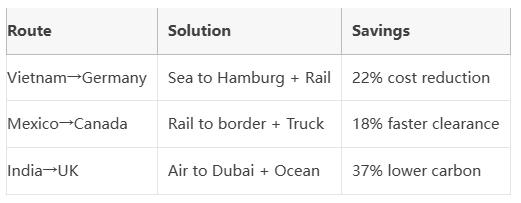Global Logistics Guide 2025: Ocean vs. Air vs. Rail Shipping – How to Choose with Cost-Saving Strategies
In an era of supply chain reconfiguration, selecting the right shipping method is your first defense against rising costs and delays.
Global logistics is undergoing seismic shifts. With cross-border e-commerce penetration reaching 28%, "deterministic logistics" has become critical – 73% of Amazon sellers rank on-time warehouse arrival as their top criterion when choosing providers.
Meanwhile, multimodal innovations are reshaping transport boundaries:
Global rail freight volumes surged 14% YoY in 2024 (World Bank)
Air cargo demand from Asia-Pacific to Africa grew 23% in Q1 2025 (IATA)
Major ports like Rotterdam now offer integrated ocean-rail solutions cutting Asia-Europe transit by 40%
Here’s how to navigate the new landscape.
The 2025 ocean freight imperative has shifted from "getting there" to "arriving predictably". Traditional shipping’s volatility causes peak-season stockouts costing sellers 15-20% of annual revenue.
Cutting-Edge Solutions
Guaranteed Transit Times: Premium services like Maersk’s TP20 now offer 14-day LAX port-to-FBA with 100% schedule reliability backed by contractual penalties.
Intelligent Customs Clearance: AI-powered platforms like Flexport reduce inspection rates to <3% (vs. industry average 9%) with automated document processing.
Emission Control: New CII regulations favor vessels with 50% lower CO2/km-ton than industry averages.
When to Choose Ocean
✅ High-value goods (>$30k/container)
✅ Non-urgent replenishment cycles (30-45 days)
✅ Sustainability-focused shipments (CO2/kg: 10g vs air’s 500g)
Air cargo isn’t just for emergencies anymore. With 2025’s e-commerce boom, it’s becoming a core strategy:
Growth Hotspots
Emerging Markets: Nigeria’s e-commerce grew 35% in 2024 – air freight bridges infrastructure gaps where road networks are underdeveloped.
Pharma Logistics: Temperature-sensitive vaccines require 72hr global delivery – specialized Pharma Wings flights ensure <2°C variance.
Industrial Crisis Response: Mining companies use pre-positioned air hubs to deliver critical parts within 48hrs, preventing $500k/day downtime.
Cost-Saving Hacks
Consolidation Programs: LCL (Less than Container Load) services from Frankfurt to Nairobi cut SME costs by 60%
Sea-Air Hybrids: Shanghai→Dubai (sea) + Dubai→Lagos (air) reduces Africa-bound costs by 45%
When to Choose Air
✅ Ultra high-value items (>$50/kg)
✅ Perishables (flowers, seafood)
✅ Supply chain disruption recovery
Rail freight is experiencing triple-digit growth on key routes, driven by carbon regulations and reliability:
Eurasian Rail Advantages
Transit Time: 18 days China→Germany vs 35+ days for ocean
Cost: 40% cheaper than air, 15% pricier than ocean
Carbon Footprint: 75% lower emissions than trucks (EU Commission Data)
Innovation Spotlight
Digital Silk Road: Real-time GPS tracking across 10,000km China-Europe routes
Blockchain Bills of Lading: Reduce documentation errors by 90%
Temperature-Controlled Railcars: Enable pharmaceutical transport at 1/3 air freight costs
When to Choose Rail
🚆 Mid-value shipments ($10k-$30k/container)
🚆 Time-sensitive Europe/Asia land cargo (15-25 days)
🚆 Carbon-conscious manufacturers (CBAM compliance)
Winning logistics strategies combine transport modes:
Top Integration Models

Tech Enablers
Dynamic Routing Algorithms: Reduce transfers by 30%
Unified Visibility Platforms: Track shipments across 5+ carriers in one dashboard
